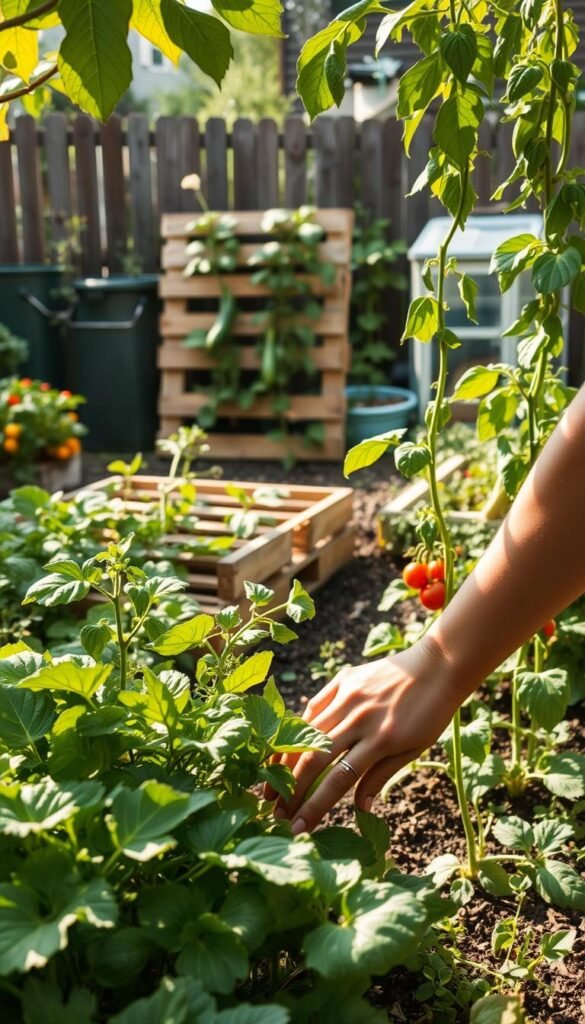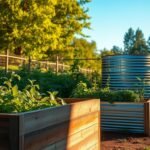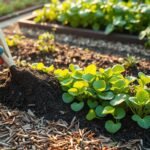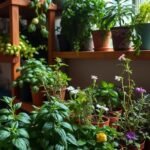Transforming your backyard into a source of fresh ingredients doesn’t require deep pockets. Many new growers worry about startup costs, but smart approaches can turn even small spaces into productive areas. Whether you’re nurturing herbs, flowers, or edible plants, the right techniques help you avoid unnecessary expenses while maximizing yields.
You might be surprised how everyday items like egg cartons or yogurt containers become perfect seedling starters. Repurposing materials cuts down on buying new supplies, letting you focus resources on quality soil or durable tools. Timing matters too – shopping for seeds during off-season sales or swapping cuttings with neighbors keeps costs low.
Building a thriving plot isn’t about perfection. It’s about learning which investments deliver the best returns. For example, prioritizing easy-to-grow crops like leafy greens ensures early successes, while composting kitchen scraps creates free fertilizer. These choices add up, making your initial effort worthwhile.
Seasoned growers know the real payoff comes later: crisp tomatoes picked minutes before dinner or fragrant basil that elevates simple meals. By starting small and focusing on sustainable practices, you’ll develop skills that make every growing season more rewarding – and affordable.
Understanding the Basics of Budget Gardening
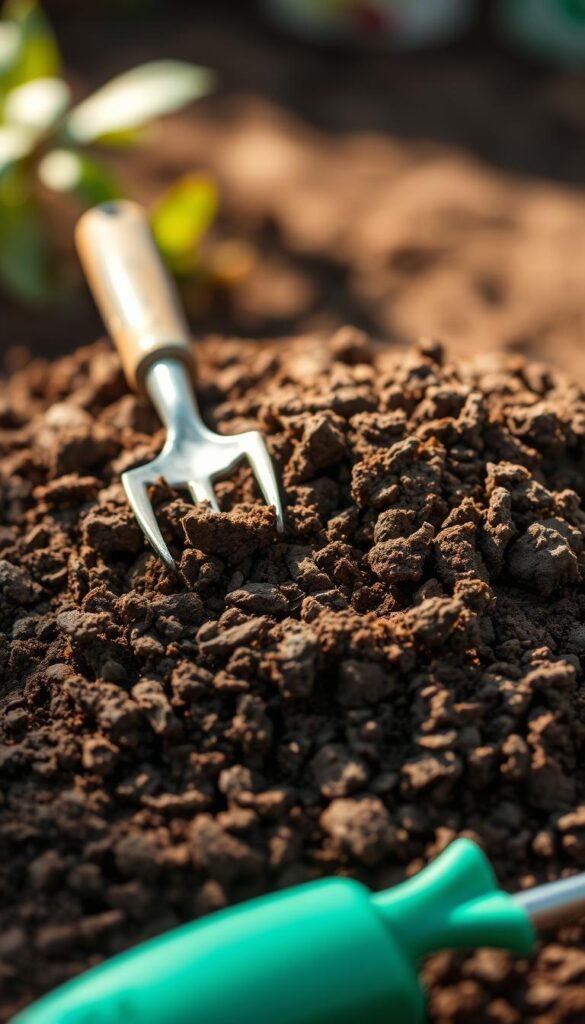
Affordable gardening starts with smart choices, not big spending. The secret lies in working with your environment rather than against it. Healthy soil acts like a savings account – the more you invest upfront, the bigger your returns later.
Key Principles of Cost-Saving Gardening
Test your soil before planting anything. Local extension offices offer $20-25 tests that reveal pH levels and nutrient gaps. This prevents wasting money on plants that’ll struggle in your ground. For example:
- Clay soil? Choose drought-tolerant varieties
- Sandy plots? Add organic matter to retain moisture
Match plants to your sunlight and space. Research requirements before buying – that $5 basil needs full sun, while mint thrives in shade. Organic gardening guides help identify low-maintenance options perfect for beginners.
Smart Soil and Seed Investment
Boost soil quality with free resources. Coffee shops often give away used grounds, and horse farms may offer aged manure. Compost food scraps to create nutrient-rich humus instead of buying bags.
Prioritize perennial herbs like rosemary over annuals. They come back yearly, reducing replanting costs. For seeds, join local swap groups – trade extra zucchini starts for tomato seedlings you need.
Building a Strong Foundation with DIY Compost and Mulch
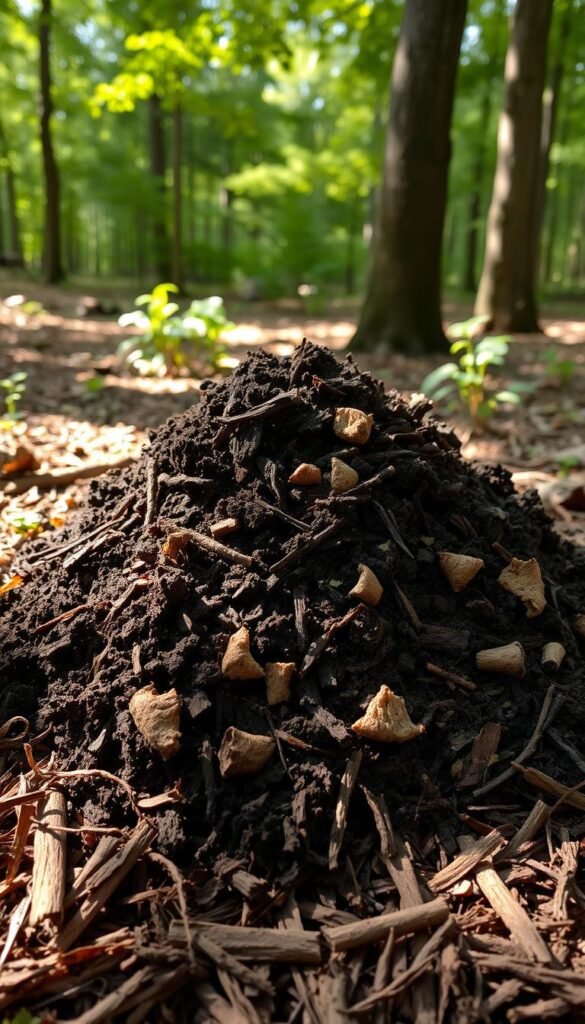
Healthy soil doesn’t have to come with a hefty price tag when nature provides free materials. By repurposing organic waste and seasonal debris, you create a nutrient-rich base that feeds plants while reducing landfill contributions. This approach saves money and builds long-term fertility.
Creating Nutrient-Rich Compost at Home
Start with a simple compost pile using kitchen scraps like banana peels and coffee grounds. Mix them with dried leaves or grass clippings to balance moisture. For small spaces, try vermicomposting with worms or Bokashi fermentation—both transform food waste into plant-ready nutrients in weeks.
“Composting turns waste into wealth for your plants,”
Utilizing Free and Upcycled Mulch Options
Autumn leaves become premium mulch when shredded with a lawnmower. Spread them 2-3 inches thick to suppress weeds and retain moisture. Contact tree removal services—many offer free wood chips to avoid disposal fees. Check community boards for chip drop events.
| Mulch Type | Source | Benefits |
|---|---|---|
| Leaf mulch | Yard waste | Improves soil structure |
| Wood chips | Tree services | Long-lasting coverage |
| Grass clippings | Lawn mowing | Quick nitrogen boost |
These methods cut watering needs by half in summer. Your garden gets free protection while organic matter breaks down into next year’s fertile soil.
DIY Vegetable Garden Hacks: Budget-Friendly Ways to Grow More Food
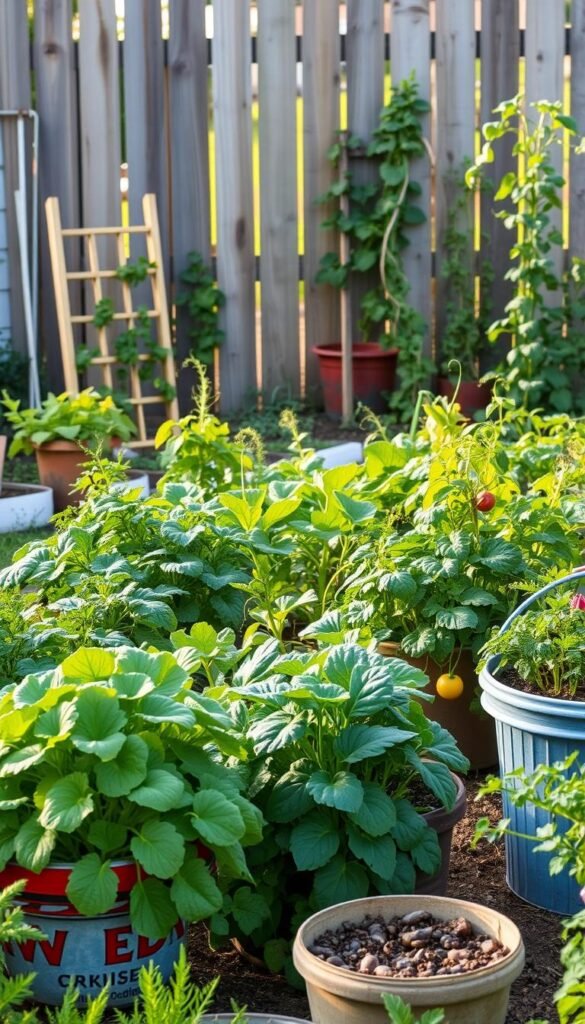
Unlock your garden’s potential by reimagining items you already own. Old pantyhose become stretchy plant ties that support tomatoes without damaging stems. Cut plastic bottles into self-watering spikes – bury them neck-down near roots for steady moisture during heat waves.
Save space with vertical growing techniques. Mount curtain rods between posts to create climbing frames for beans or peas. Try hydroponic setups using recycled containers for herbs like basil and mint. These methods triple your planting area without expanding beds.
Timing boosts yields dramatically. Sow quick-growing radishes between slower cabbage plants – harvest the radishes before cabbages need room. Plant heat-loving peppers after lettuce finishes, maximizing bed use through the season.
| Repurposed Item | Garden Use | Benefit |
|---|---|---|
| Egg cartons | Seed starters | Biodegradable transplant cells |
| Yogurt cups | Plant protectors | Shield seedlings from pests |
| Milk jugs | Cloches | Extend growing season |
| Wine bottles | Watering spikes | Deep root hydration |
Companion planting saves money and space. Grow marigolds with tomatoes to repel nematodes naturally. Basil near peppers improves flavor while deterring aphids. These partnerships reduce pesticide needs and increase harvest diversity.
Creative Seed-Starting and Plant Propagation Techniques
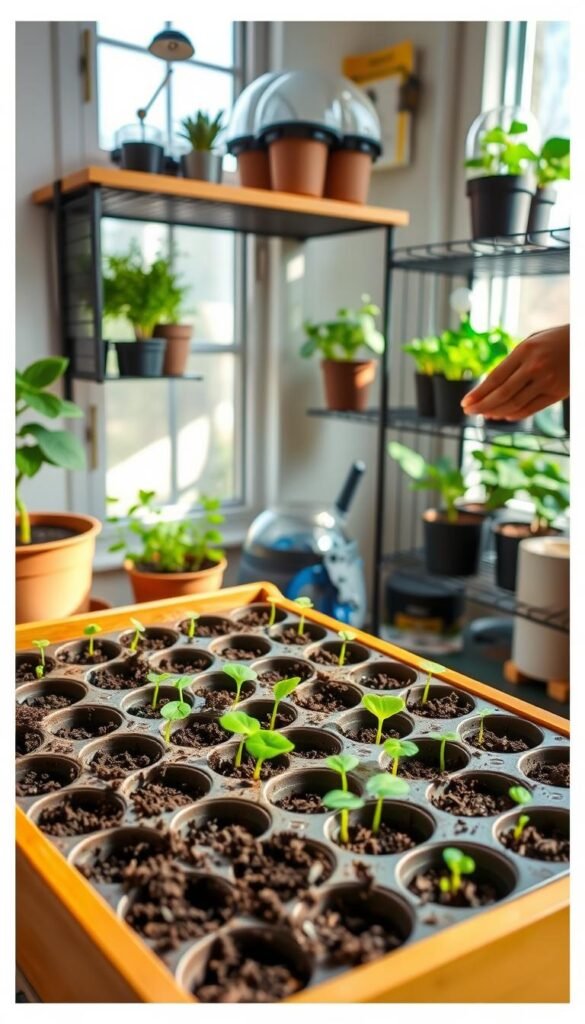
Expanding your green space doesn’t require endless spending—just clever techniques to multiply what you already have. By mastering seed-starting and propagation methods, you can turn a handful of seeds or a single plant into dozens of thriving additions to your landscape.
Starting Plants from Seed for Maximum Savings
A $3 seed packet often grows 20+ plants—up to 90% cheaper than buying nursery transplants. Fast-growing options like lettuce and radishes sprout in days, giving quick wins for beginners. Beans and basil also thrive with minimal effort.
- Egg cartons create biodegradable seedling cells
- Toilet paper tubes prevent root disturbance
- Yogurt cups with drainage holes protect young sprouts
Start seeds indoors 6-8 weeks before your last frost date. Cover trays with plastic wrap to trap humidity, removing it once sprouts appear. For stubborn varieties, dip cuttings in willow water—a natural rooting hormone.
Using Stem Cuttings and Natural Propagation
Many herbs clone themselves effortlessly. Snip 4-inch stems from mint or basil, remove lower leaves, and place in water. Roots typically form in 7-10 days. Rosemary prefers sandy soil for propagation.
“One healthy plant can become twenty through strategic cuttings,”
Advanced methods multiply perennials for free:
- Divide overgrown hostas every 3 years
- Root tomato suckers in nutrient-rich water
- Layer strawberry runners while still attached
These approaches work year-round indoors. If pests strike, targeted natural solutions protect your new plants without harsh chemicals.
Tools, Tips, and Tricks to Save Money in Your Garden
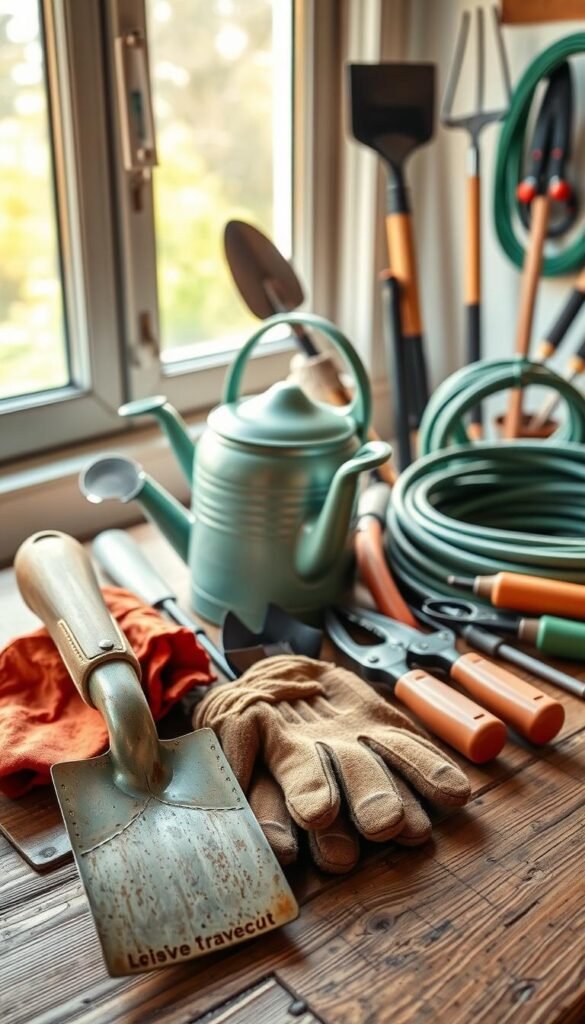
Smart gardeners know building a thriving plot involves resourcefulness as much as soil quality. Instead of overspending, focus on community connections and creative solutions that stretch every dollar. You’ll be surprised how much you can achieve with minimal upfront costs.
Borrowing, Sharing, and Upcycling Garden Tools
Start by asking neighbors if they have extra spades or pruners to lend. Many gardeners happily share tools collecting dust in their sheds. This lets you test different items before buying your own. Local libraries even loan out equipment in some areas!
Secondhand markets are goldmines for affordable supplies. Check Facebook Marketplace for gently used tools priced 50-70% below retail. Estate sales often feature high-quality hoes or watering cans for a few dollars. One gardener’s clutter becomes your bargain.
“Our community swap day turned my extra tomato cages into three herb plants,”
Repurpose household things to avoid purchases. Old spoons make perfect seedling scoops, while colanders become harvest baskets. Keep an eye out for:
- Fork handles as plant markers
- Plastic bottles as mini greenhouses
- Baking sheets for organizing seeds
| Resource | Savings Tip | Best For |
|---|---|---|
| Thrift stores | Check weekly rotations | Hand tools |
| Plant swaps | Trade extra seedlings | Rare varieties |
| End-of-season sales | Buy next year’s supplies | Soil amendments |
Clean and oil metal tools after each use to prevent rust. Sharpen blades with a $5 file—it’s cheaper than replacements. Focus first on essentials like a trowel and gloves. Fancy gadgets can wait until you’ve mastered the basics.
Effective Watering and Irrigation Strategies on a Budget
Maximizing every drop transforms how you nurture your landscape sustainably. Smart hydration keeps plants healthy without wasting resources or money. Let’s explore methods to stretch your water supply while supporting growth through dry spells.
Turn Household Items into Watering Tools
Empty wine bottles become slow-release irrigation spikes. Bury them upside-down near tomato roots for steady moisture. Use old IV tubing or milk jugs to create a DIY drip system – perfect for container setups. These hacks cut summer watering time by half.
Capture Nature’s Free Supply
Rain barrels collect thousands of gallons yearly from your roof. Attach a $5 diverter kit to gutters, directing runoff to thirsty garden beds. Stored rainwater lacks chemicals found in tap water, making it ideal for seedlings.
Group plants with similar needs together to avoid overwatering. Add mulch to lock in moisture longer. With these strategies, your yard stays lush even during droughts – all while keeping costs low.
